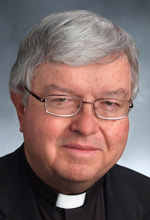Q. There was a photo in our local Catholic newspaper of a pastor presiding over a burial at sea. Please clarify the church’s teaching on cremation and the proper final resting place of the cremated remains. (I thought that the “cremains” were to be buried.) (Davenport, Iowa)
A. The Catholic Church, while it prefers a traditional burial or entombment, permits cremation. The cremated remains are to be treated with the same respect as the body of the deceased, which means that they are to be placed in a worthy vessel and buried or entombed in consecrated ground (not kept on a mantelpiece or scattered over a mountaintop).
The church allows burial at sea, provided that the body or the cremated remains are buried in a dignified and heavy container.
In the Order for Christian Funerals, No. 406, Section 4, there is a specific prayer to be used in such cases: “Lord God, by the power of your word you stilled the chaos of the primeval seas, you made the raging waters of the flood subside, and calmed the storm on the sea of Galilee. As we commit the body (earthly remains) of our brother (sister) N. to the deep, grant him/her peace and tranquility until that day when he/she and all who believe in you will be raised to the glory of new life promised in the waters of baptism.”
Q. I am a longtime practicing Catholic, but there is a question that has been bothering me: with respect to the canonization process for Pope John Paul II. How did the devil’s advocate treat the issue of the clergy sexual abuse scandal? (Marlboro, N.J.)
A. Pope John Paul II (along with Pope John XXIII) will be canonized by Pope Francis in a ceremony at the Vatican on April 27, 2014.
As your question suggests, some have objected to this decision — particularly advocates for victims of clergy sex abuse — because, they say, as the church’s leader, Pope John Paul did not act quickly enough and forcefully enough in punishing abusers and protecting children.
Especially they fault Pope John Paul for his support of the Mexican priest Father Marcial Maciel Degollado, who fostered many clerical vocations through the society he founded, the Legionaries of Christ. (Father Maciel was later determined to have abused multiple victims; he was removed from ministry by Pope Benedict XVI and ordered to spend the rest of his days in “prayer and penitence.”)
Supporters of Pope John Paul point out that he attempted to stem abuse by assigning such cases to the Vatican’s powerful Congregation for the Doctrine of the Faith and by approving an expedited process for weeding abusers out of the priesthood.
As to what was reported and discussed in the canonization process about Pope John Paul’s response to the crime, sin and scandal of sexual abuse, it is difficult to say without access to a transcript of the proceedings.
I feel confident that the matter would have been brought forward for discussion, especially given the strength of victims’ concerns. (Technically, the role is filled now not by a “devil’s advocate” but by the “relator,” who assembles material on the candidate’s life and writings as well as on the social milieu of the period.)
It is important to note that the canonization is neither a seal of approval of each decision made during Pope John Paul’s papacy nor a ratification of every policy choice. It is a statement that he was a holy man who is now with God in heaven, not necessarily a wise church leader or an effective one.
Supporters of Pope John Paul would say, in fact, that he was “all of the above,” citing his role in freeing Eastern Europe from Soviet tyranny, his international trips to promote the Gospel and his courageous example while suffering during his final years from Parkinson’s disease.
***
Questions may be sent to Father Kenneth Doyle at askfatherdoyle@gmail.com and 40 Hopewell St., Albany, N.Y. 12208.




Share this story